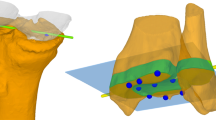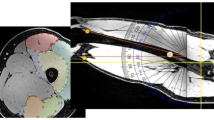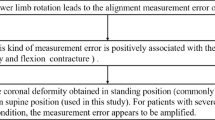Abstract
The hypothesis of this study was that length, torsion, and axis of a leg phantom can be measured accurately and reproducibly by magnetic resonance imaging (MRI) and that this can be applied to patients with leg deformities. Two phantoms and 30 patients (genu varum, n = 15; genu valgum, n = 15) were investigated using an optimized MRI technique. Reference measurements were performed with a micrometer screw and a goniometer. Patient leg length and axis were compared with long radiographs in bipedal stance. Intra- and interobserver reproducibility and accuracy were calculated using the mean absolute difference (MAD) and the 95% confidence interval. In patients, comparisons were done using a paired Student’s t-test. MAD, intraobserver MAD, and interobserver MAD were 0.03, 0.03, 0.04 mm (length); 0.98, 1.2, 0.98° (torsion); and 0.18, 0.23, 0.22° (axis), respectively. In patients, leg length was underestimated by MRI (−2.4 ± 0.7%; 1.9 ± 0.7 cm; P < 0.001). The hip-knee-ankle angle (HKA) did not show significant differences in varus knees (−0.5 ± 1.0°; P > 0.05), while it was significantly underestimated in valgus knees (−3.6 ± 2.8°; P < 0.05). The phantom study revealed that leg length, torsion, and axis can be measured accurately and reproducibly by MRI. Although underestimation of leg length and HKA in valgus knees occurred, this optimized MRI technique can be applied to patients with leg deformities.





Similar content being viewed by others
References
Paley D, Tetsworth K (1992) Mechanical axis deviation of the lower limbs. Preoperative planning of uniapical angular deformities of the tibia or femur. Clin Orthop 280:48–64
Paley D, Tetsworth K (1992) Mechanical axis deviation of the lower limbs. Preoperative planning of multiapical frontal plane angular and bowing deformities of the femur and tibia. Clin Orthop 280:65–71
Paley D, Herzenberg JE, Tetsworth K, McKie J, Bhave A (1994) Deformity planning for frontal and sagittal plane corrective osteotomies. Orthop Clin North Am 25:425–465
Keppler P, Strecker W, Kinzl L (1999) CT determination of leg length and torsion in children and adolescents. Unfallchirurg 102:936–941
Keppler P, Strecker W, Kinzl L, Simmnacher M, Claes L (1999) Sonographic imaging of leg geometry. Orthopade 28:1015–1022
Strecker W, Keppler P, Gebhard F, Kinzl L (1997) Length and torsion of the lower limb. J Bone Joint Surg Br 79:1019–1023
Kalra MK, Maher MM, Toth TL et al (2004) Strategies for CT radiation dose optimization. Radiology 230:619–628
Terjesen T, Benum P, Rossvoll I, Svenningsen S, Floystad Isern AE, Nordbo T (1991) Leg-length discrepancy measured by ultrasonography. Acta Orthop Scand 62:121–124
van der Schoot DK, Den Outer AJ, Bode PJ, Obermann WR, van Vugt AB (1996) Degenerative changes at the knee and ankle related to malunion of tibial fractures. 15-year follow-up of 88 patients. J Bone Joint Surg Br 78:722–725
Leitzes AH, Potter HG, Amaral T, Marx RG, Lyman S, Widmann RF (2005) Reliability and accuracy of MRI scanogram in the evaluation of limb length discrepancy. J Pediatr Orthop 25:747–749
Tomczak RJ, Guenther KP, Rieber A, Mergo P, Ros PR, Brambs HJ (1997) MR imaging measurement of the femoral antetorsional angle as a new technique: comparison with CT in children and adults. AJR Am J Roentgenol 168:791–794
Synder M, Vera J, Harcke HT, Bowen JR (2003) Magnetic resonance imaging of the growth plate in late-onset tibia vara. Int Orthop 27:217–222
Aamodt A, Terjesen T, Eine J, Kvistad KA (1995) Femoral anteversion measured by ultrasound and CT: a comparative study. Skelet Radiol 24:105–109
Keats TE, Teeslink R, Diamond AE, Williams JH (1966) Normal axial relationships of the major joints. Radiology 87:904–907
Hsu RWW, Himeno S, Coventry MB, Chao EYS (1990) Normal axial alignment of the lower extremity and load bearing distribution at the knee. Clin Orthop Rel Research 255:215–227
Bland JM, Altman DG (1995) Comparing methods of measurement: why plotting difference against standard method is misleading. Lancet 346:1085–1087
Bland JM, Altman DG (1990) A note on the use of the intraclass correlation coefficient in the evaluation of agreement between two methods of measurement. Comput Biol Med 20:337–340
Bland JM, Altman DG (1986) Statistical methods for assessing agreement between two methods of clinical measurement. Lancet 1:307–310
Wright JG, Treble N, Feinstein AR (1991) Measurement of lower limb alignment using long radiographs. J Bone Joint Surg Br 73:721–723
Koshino T, Takeyama M, Jiang LS, Yoshida T, Saito T (2002) Underestimation of varus angulation in knees with flexion deformity. Knee 9:275–279
Lang P, Genant HK, Jergesen HE, Murray WR (1992) Imaging of the hip joint. Computed tomography versus magnetic resonance imaging. Clin Orthop 274:135–153
Sabharwal S, Zhao C, McKeon J, Melaghari T, Blacksin M, Wenekor C (2007) Reliability analysis for radiographic measurement of limb length discrepancy: full-length standing anteroposterior radiograph versus scanogram. J Pediatr Orthop 27:46–50
Terry MA, Winell JJ, Green DW, Schneider R, Peterson M, Marx RG, Widmann RF (2005) Measurement variance in limb length discrepancy: clinical and radiographic assessment of interobserver and intraobserver variability. J Pediatr Orthop 25:197–201
Cleveland RH, Kushner DC, Ogden MC, Herman TE, Kermond W, Correia JA (1988) Determination of leg length discrepancy. A comparison of weight-bearing and supine imaging. Invest Radiol 23:301–304
Brouwer RW, Jakma TS, Bierma-Zeinstra SM, Ginai AZ, Verhaar JA (2003) The whole leg radiograph: standing versus supine for determining axial alignment. Acta Orthop Scand 74:565–568
Fishkin Z, Miller D, Ritter C, Ziv I (2002) Changes in human knee ligament stiffness secondary to osteoarthritis. J Orthop Res 20:204–207
Markolf KL, Mensch JS, Amstutz HC (1976) Stiffness and laxity of the knee - the contributions of the supporting structures. A quantitative in vitro study. J Bone Joint Surg Am 58:583–594
Saeki K, Mihalko WM, Patel V et al (2001) Stability after medial collateral ligament release in total knee arthroplasty. Clin Orthop 392:184–189
Patel VV, Hall K, Ries M, Lotz J, Ozhinsky E, Lindsey C, Lu Y, Majumdar S (2004) A three-dimensional MRI analysis of knee kinematics. J Orthop Res 22:283–292
Acknowledgements
We would like to express our gratitude to the Deutsche Arthrosehilfe for supporting this study. Additionally, we thank Ulf Henkemeier and Adel Maataoui for support in data acquisition and Monika Kriner for statistical support.
Author information
Authors and Affiliations
Corresponding author
Rights and permissions
About this article
Cite this article
Hinterwimmer, S., Graichen, H., Vogl, T.J. et al. An MRI-based technique for assessment of lower extremity deformities—reproducibility, accuracy, and clinical application. Eur Radiol 18, 1497–1505 (2008). https://doi.org/10.1007/s00330-008-0896-y
Received:
Revised:
Accepted:
Published:
Issue Date:
DOI: https://doi.org/10.1007/s00330-008-0896-y




